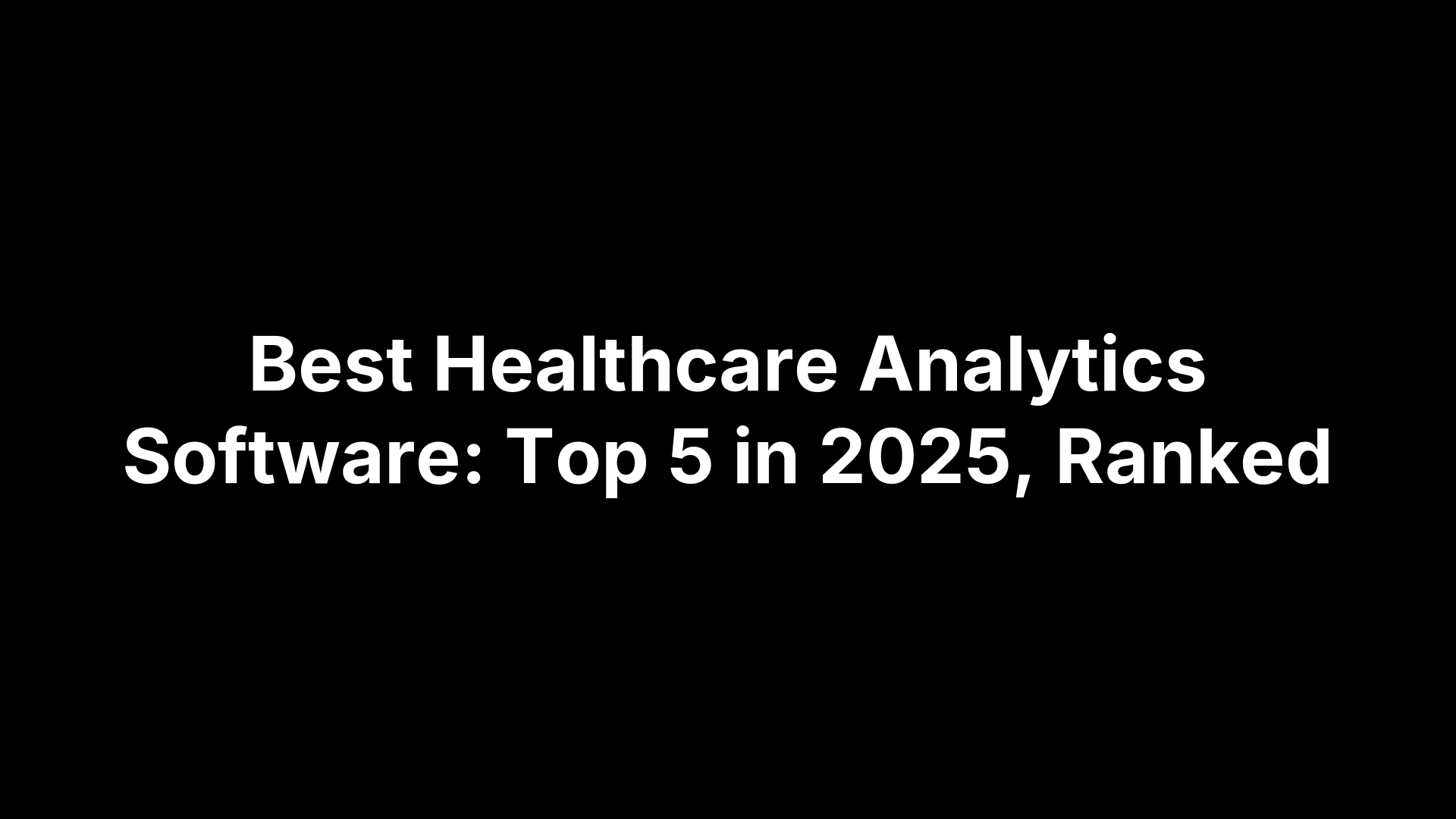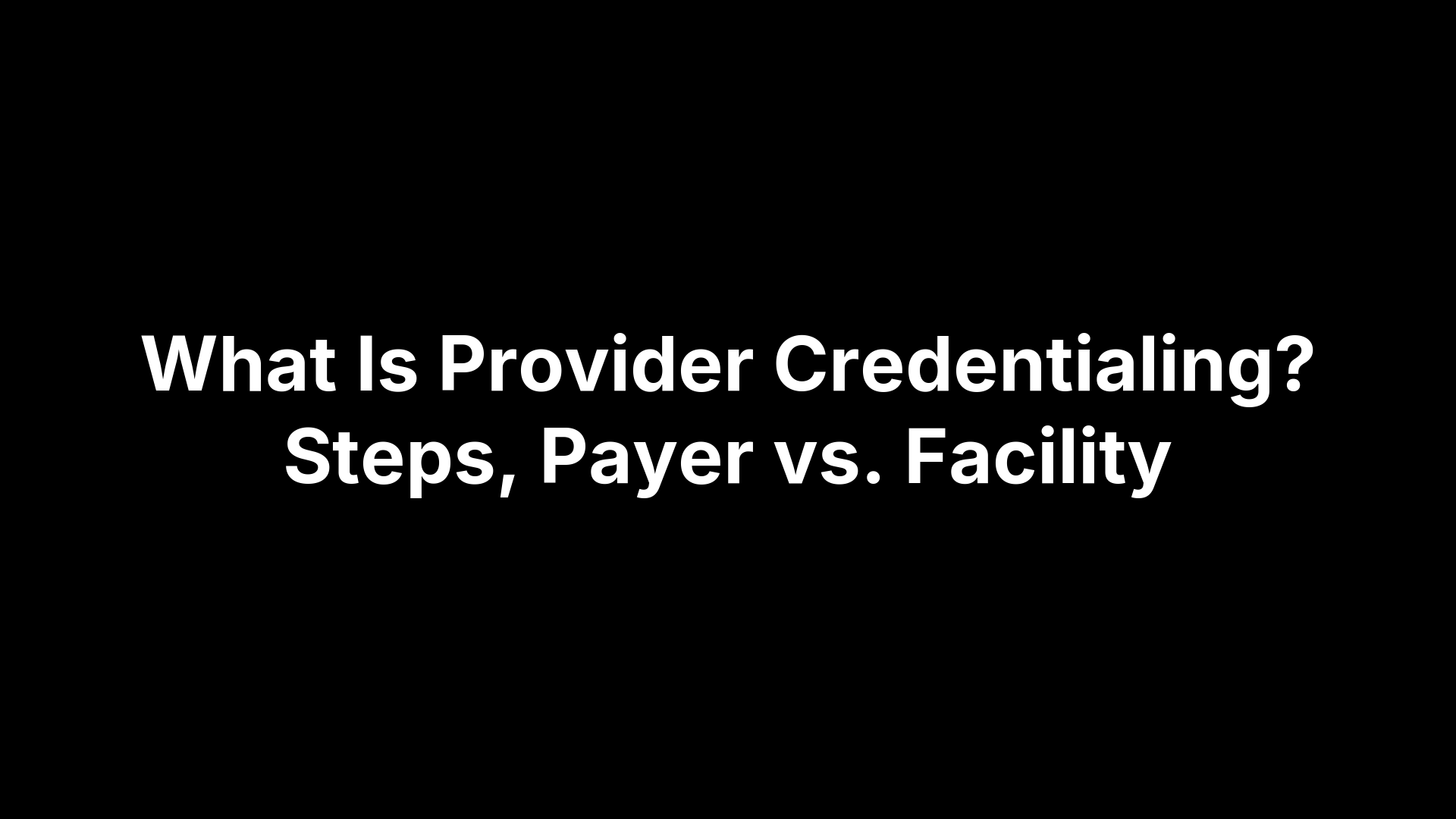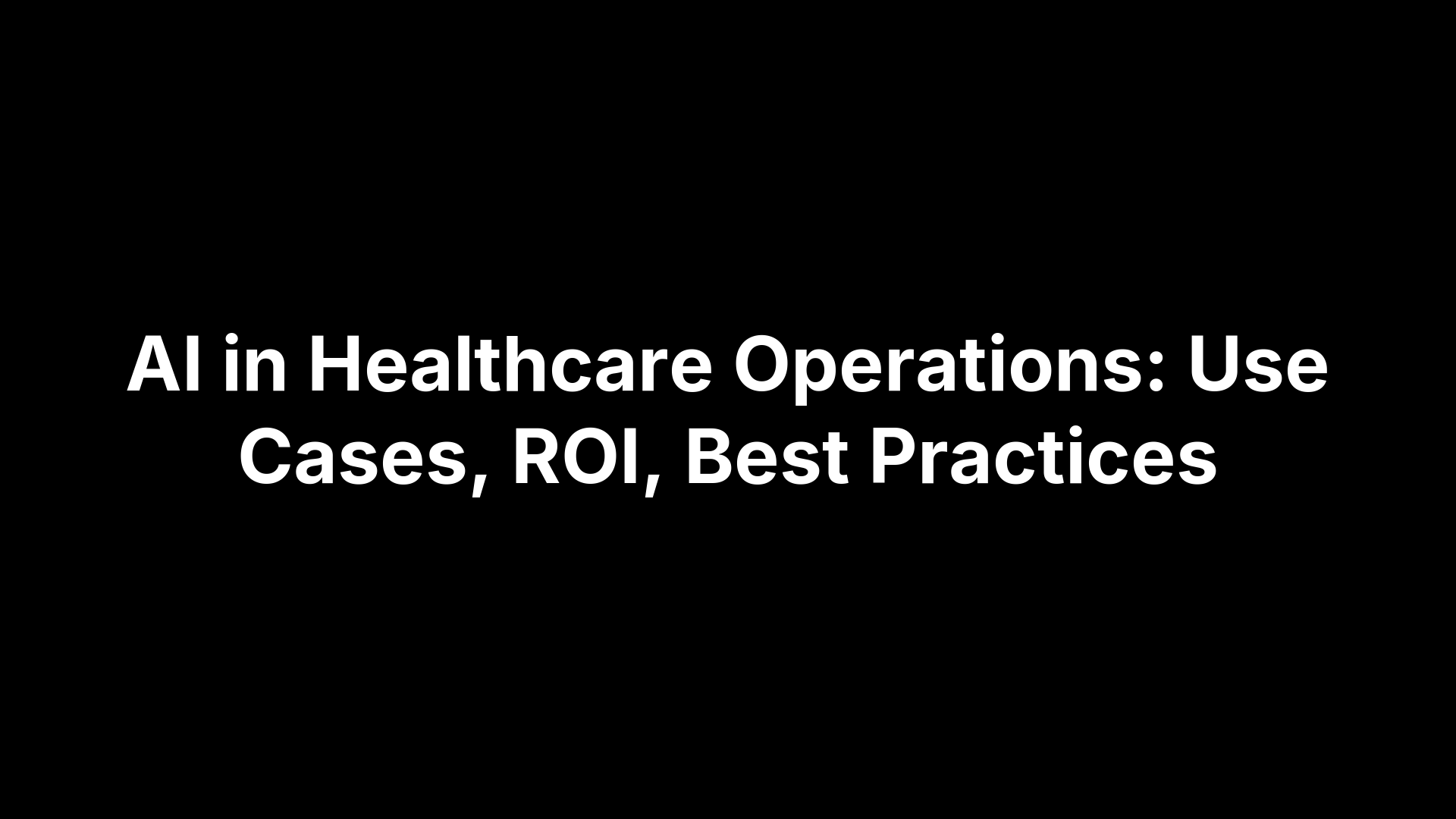Best Healthcare Analytics Software: Top 5 in 2025, Ranked


Best Healthcare Analytics Software: Top 5 in 2025, Ranked
If you’re choosing healthcare analytics software, you’re likely juggling more than dashboards. You need a platform that stitches together EHR, claims, SDOH, and operational data; delivers timely, trustworthy insights at the point of decision; embeds into workflows; and proves ROI without a 12‑month lift. The reality on the ground—siloed systems, retrospective reports, manual workarounds, and unclear pricing—makes apples‑to‑apples comparisons tough. With clinical, operational, and financial targets on the line (and strict compliance requirements), a misstep here is costly.
This guide cuts through the noise. We’ve ranked the 5 best healthcare analytics platforms for 2025 using criteria that matter to provider, payer, and service operations teams: interoperability (EHR/CAD/billing, HL7/FHIR), data breadth, AI maturity (predictive/prescriptive), workflow embedding and automation, time‑to‑value, governance and security (HIPAA/HITRUST/SOC 2), and verified customer sentiment (e.g., KLAS, published outcomes). For each pick, you’ll get a quick read on what it does best, core features, ideal fit, integrations/data sources, and how to approach pricing and demos. Whether your priority is patient logistics and dispatch, population health, cost and quality, or network performance, use this comparison to build a confident shortlist. Let’s get to the rankings.
1. VectorCare (Insights & ADI)
If your definition of the best healthcare analytics software includes turning insights into action on the same screen where work happens, VectorCare fits. Built for patient logistics and care-at-home operations, it couples cloud BI (Insights) with AI agents (ADI) that automate dispatching, scheduling, price negotiation, resource management, and billing. Customers report up to a 90% reduction in scheduling time and six‑figure annual savings for large hospitals.
What it does best
VectorCare excels at closing the gap between analytics and execution. Insights surfaces operational, clinical, and financial signals in intuitive dashboards; ADI then acts on them—auto‑dispatching rides, rebalancing resources, and pre‑validating billing—so coordinators and dispatchers focus on exceptions, not busywork.
- Operationalizes analytics: Moves from “see it” to “solve it” with AI-driven workflows.
- Patient flow acceleration: Cuts manual calls and handoffs across transport, DME, and home services.
Core features
VectorCare is a unified platform spanning analytics, automation, and vendor/network orchestration—purpose-built for transport and out-of-hospital services.
- Insights (BI): ML-powered dashboards for demand forecasting, on‑time performance, denials, and turnaround.
- ADI (AI agents): Auto‑scheduling, dynamic dispatch, price negotiation, resource allocation, and billing prep.
- Hub (workflow): No‑code workflows, protocols, secure messaging, PCS form signatures.
- Trust (vendor network): Onboarding, credentialing, policy enforcement, performance tracking.
- Pay (payments): Custom invoicing, ACH/credit card, notifications.
- Connect (integrations): EHR/CAD/billing connectors to unify work.
Who it’s best for
Organizations with complex patient movement and care‑at‑home logistics needing faster throughput, lower cost per encounter, and fewer phone calls.
- Hospitals, transfer centers, and care coordination hubs
- EMS, ambulance, and NEMT providers
- Home health and DME suppliers
- Payers and public agencies managing contracted networks
Integrations and data sources
VectorCare Connect supports bidirectional data flows to keep analytics and automations current across systems without swivel‑chairing.
- EHR, CAD, and billing systems via standards (HL7/FHIR), flat files, and APIs
- Vendor/NEMT networks, DME suppliers, pharmacies, and scheduling feeds
- Operational telemetry (timestamps, statuses, geolocation) and claims/authorization data
Pricing and demo
Custom pricing based on volume, modules (Insights, ADI, Hub, Trust, Pay), and integration scope. Typical deployments prioritize a fast time‑to‑value pilot (e.g., transport or DME) before expanding. Request a demo from sales to review your workflows, data sources, and ROI model.
2. Innovaccer data & analytics (DAP, PHM, InGraph)
If you’re evaluating the best healthcare analytics software for population health and value‑based performance, Innovaccer belongs on your shortlist. Their Data Activation Platform (DAP) unifies payer and provider data, while PHM and InGraph push actionable insights to teams. Innovaccer’s PHM has been ranked #1 by Black Book for three consecutive years, and KLAS’ 2025 report highlights Innovaccer for strong vendor support in operationalizing insights.
What it does best
Innovaccer shines at turning fragmented clinical and claims data into a single, governed layer that powers care management, risk adjustment, quality, and network performance programs—then driving measurable action at scale.
- Data activation at enterprise scale: Aggregates and normalizes multi‑source data to fuel analytics and workflows.
- Proven PHM performance: Recognized for helping organizations improve outcomes and efficiency across value‑based contracts.
- Governance and compliance: Enterprise‑grade controls and certifications (HIPAA, HITRUST, SOC 2 Type II, NCQA), with secure interoperability across payer and provider systems.
Core features
Innovaccer’s portfolio covers analytics, care orchestration, and front‑line enablement to move metrics, not just report them.
- DAP: Unified data layer for analytics, apps, and API access.
- PHM: Population health tools for risk, quality, utilization, and care management.
- InGraph: Advanced analytics and dashboards for performance tracking.
- Patient 360: Longitudinal patient records for coordinated care.
- InCare & InNote: Care team workflows and clinical enablement at the point of care.
Who it’s best for
Organizations managing risk and scale who need robust analytics plus operational follow‑through.
- IDNs, ACOs, and health systems focused on PHM and quality
- Payers and risk‑bearing entities optimizing cost and outcomes
- Clinically integrated networks aligning providers on shared goals
Integrations and data sources
DAP ingests and harmonizes claims and clinical data, then exposes insights for cost, utilization, quality, network, and performance programs—backed by secure interoperability across payer and provider systems.
- EHR and clinical feeds, labs, encounters
- Payer claims and authorization data
- Operational and performance metrics used in value‑based care
Pricing and demo
Custom pricing based on modules, populations, and integration scope. Expect a phased rollout (e.g., PHM and InGraph first) with defined outcome targets. Request a demo to map use cases, data readiness, and ROI expectations.
3. Arcadia Analytics
Arcadia is a frequent pick on shortlists for the best healthcare analytics software when the mandate is to unify claims and clinical data for population health, quality, and cost performance. Recognized five times by KLAS Research and featured in KLAS’ Data & Analytics Platforms segment, Arcadia positions its platform as best-in-class for improving healthcare experiences with measurable impact.
What it does best
Arcadia focuses on turning fragmented data into program-ready insights for PHM and value-based care, with an emphasis on performance improvement rather than static reporting.
- Population-level insight to action: Cohorts, gaps, and benchmarks aligned to quality and cost goals.
- Claims + clinical harmonization: A foundational strength for utilization, risk, and network analytics.
- Program performance transparency: Operational views that help leaders course-correct in near real time.
Core features
Arcadia’s capabilities map to enterprise analytics needs across clinical, operational, and financial domains.
- Unified analytics layer: Aggregation and normalization across sources for consistent metrics.
- Population health analytics: Risk, utilization, quality, and cost views for PHM programs.
- Performance dashboards: Role-based scorecards for executives, care teams, and operations.
- Cohorting and segmentation: Identify high-need populations and track intervention impact.
- Self-service analysis: Enable analysts to explore data without heavy IT lifts.
Who it’s best for
- IDNs/health systems advancing PHM and value-based contracts
- ACOs and CINs aligning providers to shared quality and cost targets
- Payers/risk-bearing entities needing network, utilization, and performance insight
Integrations and data sources
- EHR data feeds (encounters, labs, clinical documentation)
- Payer claims and authorizations
- Operational data supporting utilization and performance tracking
- Standard interfaces/APIs to move curated insights into downstream tools
Pricing and demo
Pricing is customized based on populations, modules, and integration scope. Expect a phased rollout tied to PHM or quality targets, with clear baselines and outcome measures. Request a demo to review data readiness, target programs, and an outcomes-based roadmap.
4. Health Catalyst (Ignite platform)
Health Catalyst’s Ignite platform is built to help enterprise teams operationalize clinical, operational, and financial improvement. It combines governed data engineering with accessible analytics and program workflows. KLAS notes Health Catalyst customers use a high number of data types; some also report frustrations with cost and product development—so scoping and outcomes alignment are key.
What it does best
Ignite excels at turning multi-source data into consistent, program-ready insights and pushing them into the hands of leaders and care teams who can act.
- Enterprise data ops: Strong ingestion, normalization, and governance.
- Insight-to-action at scale: PHM and performance views tied to improvement programs.
Core features
Ignite functions as a healthcare data and analytics ecosystem with tools for both engineers and front-line users.
- Data ingestion & management: Source template library, job scheduling, and data profiling.
- Unified data model: Terminology management and proactive data quality rules.
- Self-service analytics: Pop Analyzer for cohorts; integrate with preferred BI/AI tools.
- PHM/performance: Clinical, operational, and financial transformation use cases.
Who it’s best for
Teams that need a governed data foundation plus scalable analytics for value-based performance.
- IDNs/health systems advancing PHM, quality, and utilization.
- ACOs/CINs coordinating network performance.
- Analytics COEs standardizing data and measures.
Integrations and data sources
Ignite is designed to harmonize claims and clinical feeds and publish consistent metrics across the enterprise.
- EHR, claims, labs, and operational feeds via batch/APIs.
- Standardized vocabularies/terminologies for measure consistency.
- Curated exports/APIs to downstream apps and BI.
Pricing and demo
Pricing is custom based on populations, modules, and integration scope. Given KLAS feedback on cost, set clear outcome targets and a phased roadmap (e.g., PHM or quality pilots first). Request a demo to review data readiness, measures, and an outcomes-based deployment plan.
5. Clarify Health (Atlas platform)
Clarify Health’s Atlas platform earns a spot among the best healthcare analytics software for teams that need defensible benchmarks and predictive insight to guide value-based strategy. Atlas maps patient journeys and layers AI-powered predictions on top, while features like “Blue diamonds” provide case‑mix–adjusted expected values so leaders can compare performance fairly and target improvements with confidence.
What it does best
Clarify is purpose-built for market and performance intelligence—helping organizations see where they stand versus peers, what “good” looks like after adjustment, and where to intervene to move cost and quality metrics.
- Benchmark with context: Case‑mix–adjusted expected values (“Blue diamonds”) prevent apples‑to‑oranges comparisons.
- Journey analytics with predictions: Atlas visualizes patient flows and generates AI-driven forecasts to prioritize action.
Core features
- Atlas: Cloud platform for mapping patient journeys and producing AI‑powered predictions.
- Blue diamonds: Case‑mix–adjusted expected values at patient and provider levels.
- Comprehensive performance insights: Trends, benchmarks, and opportunity areas across care dimensions.
- Non‑Public Analyses (NPAs): Access to unique analyses based on Medicare data.
Who it’s best for
- Health system and payer strategy teams aligning value-based goals to realistic, risk‑adjusted targets.
- Service line leaders and CINs/ACOs needing fair peer comparisons and clear opportunity sizing.
- Network management teams optimizing referrals, leakage, and performance contracts.
Integrations and data sources
Clarify emphasizes a large data library power base, including NPAs derived from Medicare data. Atlas supports claims‑based patient journey mapping and AI predictions; organizations can pair these insights with their internal performance data to drive programs.
Pricing and demo
Pricing is customized by scope, modules, and data access (e.g., NPAs). In demos, confirm access to desired benchmarks, case‑mix logic, and how predictions feed your workflows. Start with a focused use case (e.g., service line or contract) and align on target outcomes.
Next steps
You’ve got a strong shortlist—now make it real. Start by naming the two or three outcomes that matter most (e.g., readmissions, on‑time transports, authorization turnaround), confirm data readiness (claims + EHR + operational), and set a 90‑day pilot with day‑one KPIs, governance, and integration checkpoints. Push vendors to show insight‑to‑action inside workflows, not just dashboards, and require transparent pricing tied to modules, volumes, and services. The goal isn’t a prettier report; it’s measurable lift within one quarter.
If your priority is patient logistics and care‑at‑home operations, pair analytics with automation. See how Insights and ADI can cut scheduling time and streamline dispatch on a unified platform at VectorCare. Ask for a discovery session with ROI modeling and a time‑boxed pilot plan.
The Future of Patient Logistics
Exploring the future of all things related to patient logistics, technology and how AI is going to re-shape the way we deliver care.



